Hunger in Sri Lanka: Causes and Solutions
VerifiedAdded on 2023/01/18
|10
|2758
|44
AI Summary
This article discusses the issue of hunger in Sri Lanka and its impact on the country's development. It explores the historical, cultural, and structural factors contributing to the problem and provides an analysis of the current situation. The article also highlights the efforts being made to address hunger and malnutrition in the country.
Contribute Materials
Your contribution can guide someone’s learning journey. Share your
documents today.
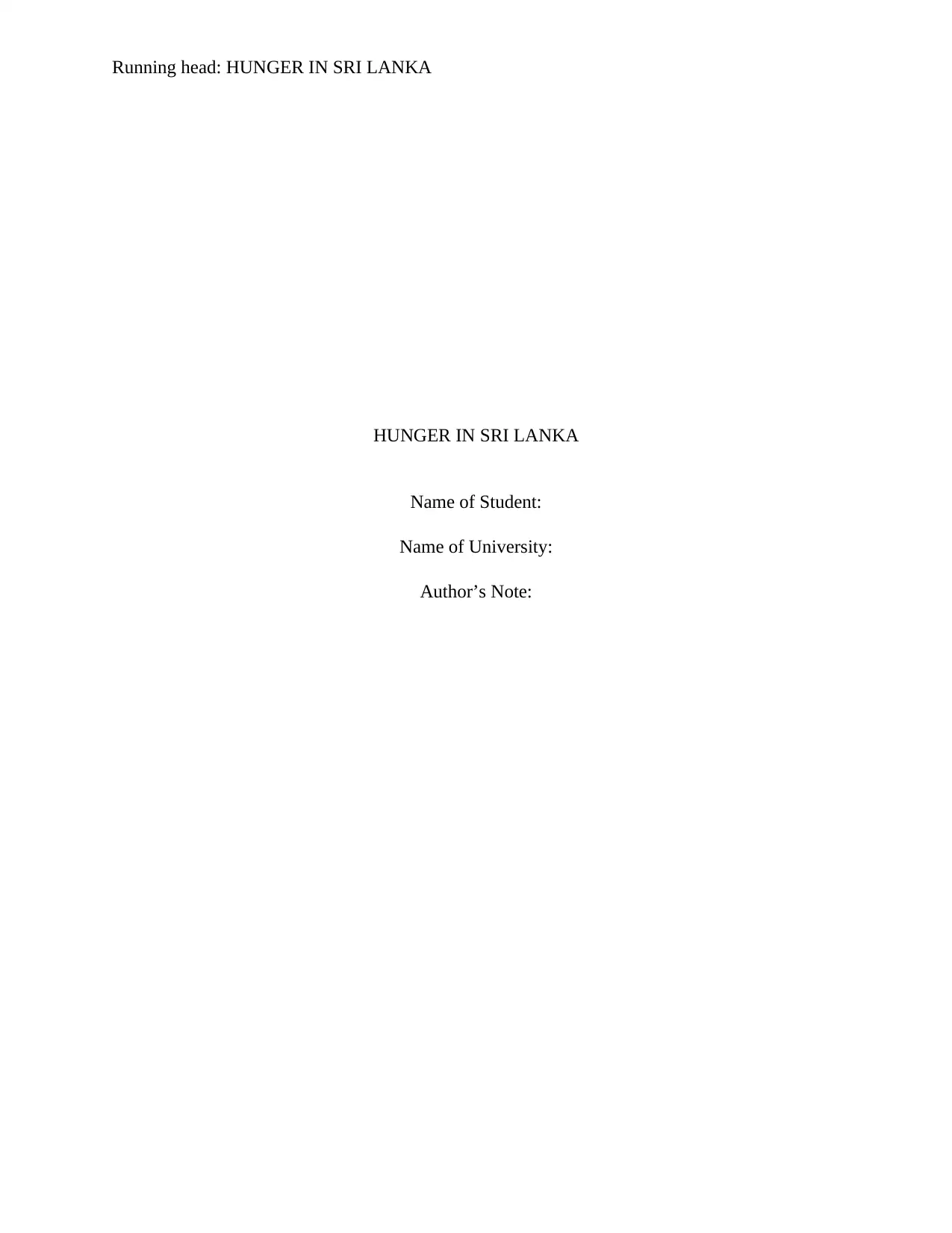
Running head: HUNGER IN SRI LANKA
HUNGER IN SRI LANKA
Name of Student:
Name of University:
Author’s Note:
HUNGER IN SRI LANKA
Name of Student:
Name of University:
Author’s Note:
Secure Best Marks with AI Grader
Need help grading? Try our AI Grader for instant feedback on your assignments.
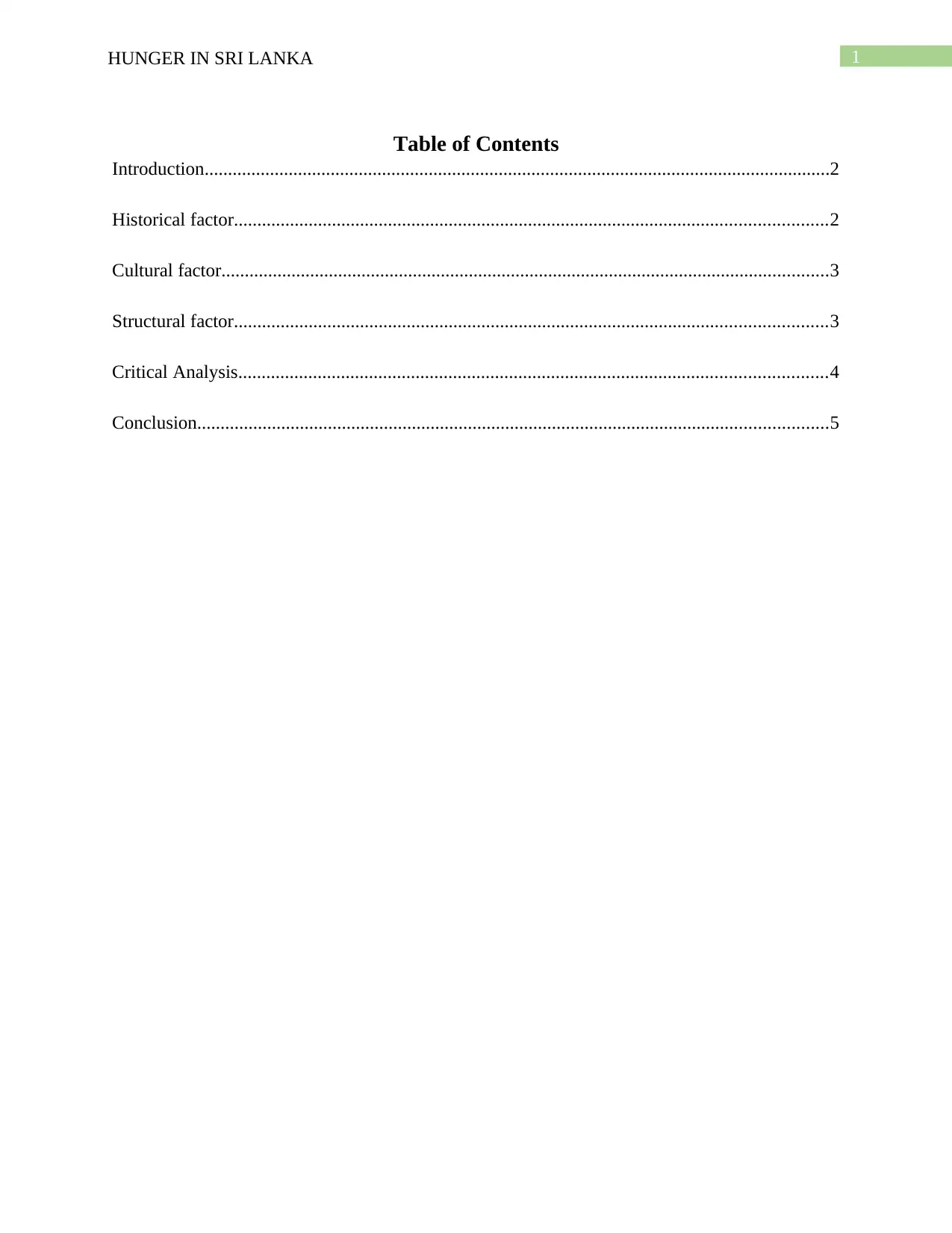
1HUNGER IN SRI LANKA
Table of Contents
Introduction......................................................................................................................................2
Historical factor...............................................................................................................................2
Cultural factor..................................................................................................................................3
Structural factor...............................................................................................................................3
Critical Analysis..............................................................................................................................4
Conclusion.......................................................................................................................................5
Table of Contents
Introduction......................................................................................................................................2
Historical factor...............................................................................................................................2
Cultural factor..................................................................................................................................3
Structural factor...............................................................................................................................3
Critical Analysis..............................................................................................................................4
Conclusion.......................................................................................................................................5
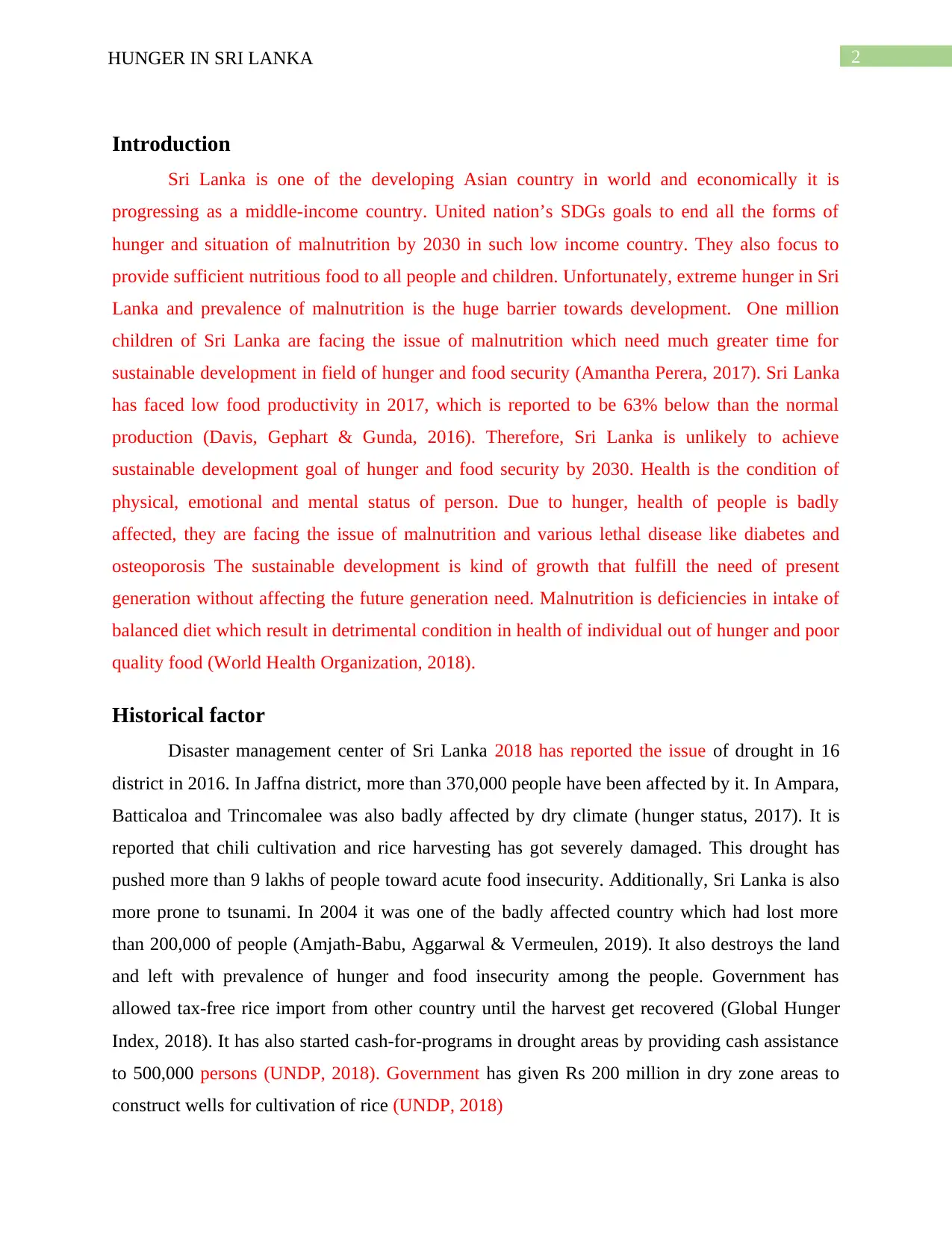
2HUNGER IN SRI LANKA
Introduction
Sri Lanka is one of the developing Asian country in world and economically it is
progressing as a middle-income country. United nation’s SDGs goals to end all the forms of
hunger and situation of malnutrition by 2030 in such low income country. They also focus to
provide sufficient nutritious food to all people and children. Unfortunately, extreme hunger in Sri
Lanka and prevalence of malnutrition is the huge barrier towards development. One million
children of Sri Lanka are facing the issue of malnutrition which need much greater time for
sustainable development in field of hunger and food security (Amantha Perera, 2017). Sri Lanka
has faced low food productivity in 2017, which is reported to be 63% below than the normal
production (Davis, Gephart & Gunda, 2016). Therefore, Sri Lanka is unlikely to achieve
sustainable development goal of hunger and food security by 2030. Health is the condition of
physical, emotional and mental status of person. Due to hunger, health of people is badly
affected, they are facing the issue of malnutrition and various lethal disease like diabetes and
osteoporosis The sustainable development is kind of growth that fulfill the need of present
generation without affecting the future generation need. Malnutrition is deficiencies in intake of
balanced diet which result in detrimental condition in health of individual out of hunger and poor
quality food (World Health Organization, 2018).
Historical factor
Disaster management center of Sri Lanka 2018 has reported the issue of drought in 16
district in 2016. In Jaffna district, more than 370,000 people have been affected by it. In Ampara,
Batticaloa and Trincomalee was also badly affected by dry climate (hunger status, 2017). It is
reported that chili cultivation and rice harvesting has got severely damaged. This drought has
pushed more than 9 lakhs of people toward acute food insecurity. Additionally, Sri Lanka is also
more prone to tsunami. In 2004 it was one of the badly affected country which had lost more
than 200,000 of people (Amjath-Babu, Aggarwal & Vermeulen, 2019). It also destroys the land
and left with prevalence of hunger and food insecurity among the people. Government has
allowed tax-free rice import from other country until the harvest get recovered (Global Hunger
Index, 2018). It has also started cash-for-programs in drought areas by providing cash assistance
to 500,000 persons (UNDP, 2018). Government has given Rs 200 million in dry zone areas to
construct wells for cultivation of rice (UNDP, 2018)
Introduction
Sri Lanka is one of the developing Asian country in world and economically it is
progressing as a middle-income country. United nation’s SDGs goals to end all the forms of
hunger and situation of malnutrition by 2030 in such low income country. They also focus to
provide sufficient nutritious food to all people and children. Unfortunately, extreme hunger in Sri
Lanka and prevalence of malnutrition is the huge barrier towards development. One million
children of Sri Lanka are facing the issue of malnutrition which need much greater time for
sustainable development in field of hunger and food security (Amantha Perera, 2017). Sri Lanka
has faced low food productivity in 2017, which is reported to be 63% below than the normal
production (Davis, Gephart & Gunda, 2016). Therefore, Sri Lanka is unlikely to achieve
sustainable development goal of hunger and food security by 2030. Health is the condition of
physical, emotional and mental status of person. Due to hunger, health of people is badly
affected, they are facing the issue of malnutrition and various lethal disease like diabetes and
osteoporosis The sustainable development is kind of growth that fulfill the need of present
generation without affecting the future generation need. Malnutrition is deficiencies in intake of
balanced diet which result in detrimental condition in health of individual out of hunger and poor
quality food (World Health Organization, 2018).
Historical factor
Disaster management center of Sri Lanka 2018 has reported the issue of drought in 16
district in 2016. In Jaffna district, more than 370,000 people have been affected by it. In Ampara,
Batticaloa and Trincomalee was also badly affected by dry climate (hunger status, 2017). It is
reported that chili cultivation and rice harvesting has got severely damaged. This drought has
pushed more than 9 lakhs of people toward acute food insecurity. Additionally, Sri Lanka is also
more prone to tsunami. In 2004 it was one of the badly affected country which had lost more
than 200,000 of people (Amjath-Babu, Aggarwal & Vermeulen, 2019). It also destroys the land
and left with prevalence of hunger and food insecurity among the people. Government has
allowed tax-free rice import from other country until the harvest get recovered (Global Hunger
Index, 2018). It has also started cash-for-programs in drought areas by providing cash assistance
to 500,000 persons (UNDP, 2018). Government has given Rs 200 million in dry zone areas to
construct wells for cultivation of rice (UNDP, 2018)

3HUNGER IN SRI LANKA
Cultural factor
The culture of Sri Lanka has shifted by the onset of European colonization. With the
acquisition of British people in Sri Lanka, most of the rice production was imported to their
country due to which Sri Lanka has faced the issue of food scarcity. As the consequence of this,
planation agriculture has changed with time. This has affected the total production of rice, due to
which people has to face malnutrition condition. Sri Lanka’s staple meal include rice with
vegetables, egg, fish and meat (World Health Organization, 2018). However, current People of
Sri Lanka are switching to rich food high in fats, sugars, salt in order to satisfy their food
requirement (World Food Programme, 2019). As the outcome for this, people are facing the
issue of food insecurity and hunger. There is a common belief among Sri Lanka people that with
consumption of certain food low in nutrition increase the complexity of new born baby (Ashraf,
Field, Rusconi, Voena & Ziparo, 2017). As the result, people of Sri Lanka suffer from acute
malnutrition, diarrhea and poor health condition (World Health Organization, 2018).
Structural factor
Rate of employment in Sri Lanka is quite low, which has increased only to 9.54 % in 5
years (Sarvananthan, 2016). The income level and pattern of income distribution is one of the
structural factor that has determine the food insecurity. The income of peoples is low and they
are not able to fulfil their nutrient level (united nation, 2018). About 23 % of household of Sri
Lanka are affected by poverty and good insecurity due to low household income, inadequate
sanitation and limited access to media (De Silva, 2016). Nearly 47.9 % of people are ignorant
toward balanced diet, as the result they face hunger and are more likely to get affected by lethal
disease (Jayasinghe, Smith, Chai & Ratnasiri, 2016). Looking into the education system of Sri
Lanka, 92% of people are highly educated, which has influence the awareness of harmful impact
of malnutrition and poverty (Corea, Karunanayake & Ginige). People are themselves taking step
to solve these issues. Sri Lanka is the second largest in trading good, estimating about 31% of
export in 2015 (Xu, 2017). However, in term of food, it imposes high tariff of about 15 % in
agricultural and food product (Hein, 2017). Additionally, many agricultural products impose
specific tariff which is higher.
Cultural factor
The culture of Sri Lanka has shifted by the onset of European colonization. With the
acquisition of British people in Sri Lanka, most of the rice production was imported to their
country due to which Sri Lanka has faced the issue of food scarcity. As the consequence of this,
planation agriculture has changed with time. This has affected the total production of rice, due to
which people has to face malnutrition condition. Sri Lanka’s staple meal include rice with
vegetables, egg, fish and meat (World Health Organization, 2018). However, current People of
Sri Lanka are switching to rich food high in fats, sugars, salt in order to satisfy their food
requirement (World Food Programme, 2019). As the outcome for this, people are facing the
issue of food insecurity and hunger. There is a common belief among Sri Lanka people that with
consumption of certain food low in nutrition increase the complexity of new born baby (Ashraf,
Field, Rusconi, Voena & Ziparo, 2017). As the result, people of Sri Lanka suffer from acute
malnutrition, diarrhea and poor health condition (World Health Organization, 2018).
Structural factor
Rate of employment in Sri Lanka is quite low, which has increased only to 9.54 % in 5
years (Sarvananthan, 2016). The income level and pattern of income distribution is one of the
structural factor that has determine the food insecurity. The income of peoples is low and they
are not able to fulfil their nutrient level (united nation, 2018). About 23 % of household of Sri
Lanka are affected by poverty and good insecurity due to low household income, inadequate
sanitation and limited access to media (De Silva, 2016). Nearly 47.9 % of people are ignorant
toward balanced diet, as the result they face hunger and are more likely to get affected by lethal
disease (Jayasinghe, Smith, Chai & Ratnasiri, 2016). Looking into the education system of Sri
Lanka, 92% of people are highly educated, which has influence the awareness of harmful impact
of malnutrition and poverty (Corea, Karunanayake & Ginige). People are themselves taking step
to solve these issues. Sri Lanka is the second largest in trading good, estimating about 31% of
export in 2015 (Xu, 2017). However, in term of food, it imposes high tariff of about 15 % in
agricultural and food product (Hein, 2017). Additionally, many agricultural products impose
specific tariff which is higher.
Secure Best Marks with AI Grader
Need help grading? Try our AI Grader for instant feedback on your assignments.
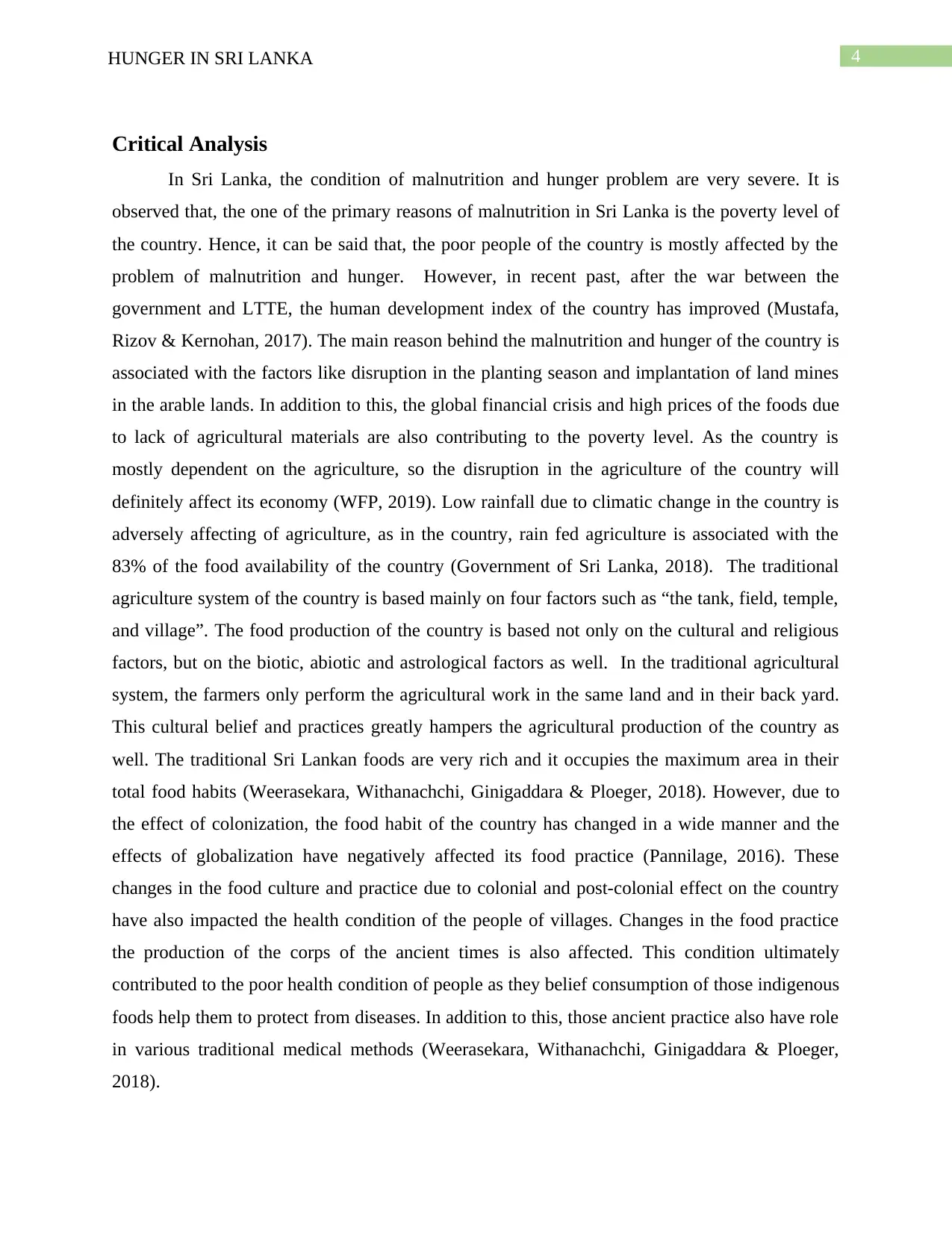
4HUNGER IN SRI LANKA
Critical Analysis
In Sri Lanka, the condition of malnutrition and hunger problem are very severe. It is
observed that, the one of the primary reasons of malnutrition in Sri Lanka is the poverty level of
the country. Hence, it can be said that, the poor people of the country is mostly affected by the
problem of malnutrition and hunger. However, in recent past, after the war between the
government and LTTE, the human development index of the country has improved (Mustafa,
Rizov & Kernohan, 2017). The main reason behind the malnutrition and hunger of the country is
associated with the factors like disruption in the planting season and implantation of land mines
in the arable lands. In addition to this, the global financial crisis and high prices of the foods due
to lack of agricultural materials are also contributing to the poverty level. As the country is
mostly dependent on the agriculture, so the disruption in the agriculture of the country will
definitely affect its economy (WFP, 2019). Low rainfall due to climatic change in the country is
adversely affecting of agriculture, as in the country, rain fed agriculture is associated with the
83% of the food availability of the country (Government of Sri Lanka, 2018). The traditional
agriculture system of the country is based mainly on four factors such as “the tank, field, temple,
and village”. The food production of the country is based not only on the cultural and religious
factors, but on the biotic, abiotic and astrological factors as well. In the traditional agricultural
system, the farmers only perform the agricultural work in the same land and in their back yard.
This cultural belief and practices greatly hampers the agricultural production of the country as
well. The traditional Sri Lankan foods are very rich and it occupies the maximum area in their
total food habits (Weerasekara, Withanachchi, Ginigaddara & Ploeger, 2018). However, due to
the effect of colonization, the food habit of the country has changed in a wide manner and the
effects of globalization have negatively affected its food practice (Pannilage, 2016). These
changes in the food culture and practice due to colonial and post-colonial effect on the country
have also impacted the health condition of the people of villages. Changes in the food practice
the production of the corps of the ancient times is also affected. This condition ultimately
contributed to the poor health condition of people as they belief consumption of those indigenous
foods help them to protect from diseases. In addition to this, those ancient practice also have role
in various traditional medical methods (Weerasekara, Withanachchi, Ginigaddara & Ploeger,
2018).
Critical Analysis
In Sri Lanka, the condition of malnutrition and hunger problem are very severe. It is
observed that, the one of the primary reasons of malnutrition in Sri Lanka is the poverty level of
the country. Hence, it can be said that, the poor people of the country is mostly affected by the
problem of malnutrition and hunger. However, in recent past, after the war between the
government and LTTE, the human development index of the country has improved (Mustafa,
Rizov & Kernohan, 2017). The main reason behind the malnutrition and hunger of the country is
associated with the factors like disruption in the planting season and implantation of land mines
in the arable lands. In addition to this, the global financial crisis and high prices of the foods due
to lack of agricultural materials are also contributing to the poverty level. As the country is
mostly dependent on the agriculture, so the disruption in the agriculture of the country will
definitely affect its economy (WFP, 2019). Low rainfall due to climatic change in the country is
adversely affecting of agriculture, as in the country, rain fed agriculture is associated with the
83% of the food availability of the country (Government of Sri Lanka, 2018). The traditional
agriculture system of the country is based mainly on four factors such as “the tank, field, temple,
and village”. The food production of the country is based not only on the cultural and religious
factors, but on the biotic, abiotic and astrological factors as well. In the traditional agricultural
system, the farmers only perform the agricultural work in the same land and in their back yard.
This cultural belief and practices greatly hampers the agricultural production of the country as
well. The traditional Sri Lankan foods are very rich and it occupies the maximum area in their
total food habits (Weerasekara, Withanachchi, Ginigaddara & Ploeger, 2018). However, due to
the effect of colonization, the food habit of the country has changed in a wide manner and the
effects of globalization have negatively affected its food practice (Pannilage, 2016). These
changes in the food culture and practice due to colonial and post-colonial effect on the country
have also impacted the health condition of the people of villages. Changes in the food practice
the production of the corps of the ancient times is also affected. This condition ultimately
contributed to the poor health condition of people as they belief consumption of those indigenous
foods help them to protect from diseases. In addition to this, those ancient practice also have role
in various traditional medical methods (Weerasekara, Withanachchi, Ginigaddara & Ploeger,
2018).
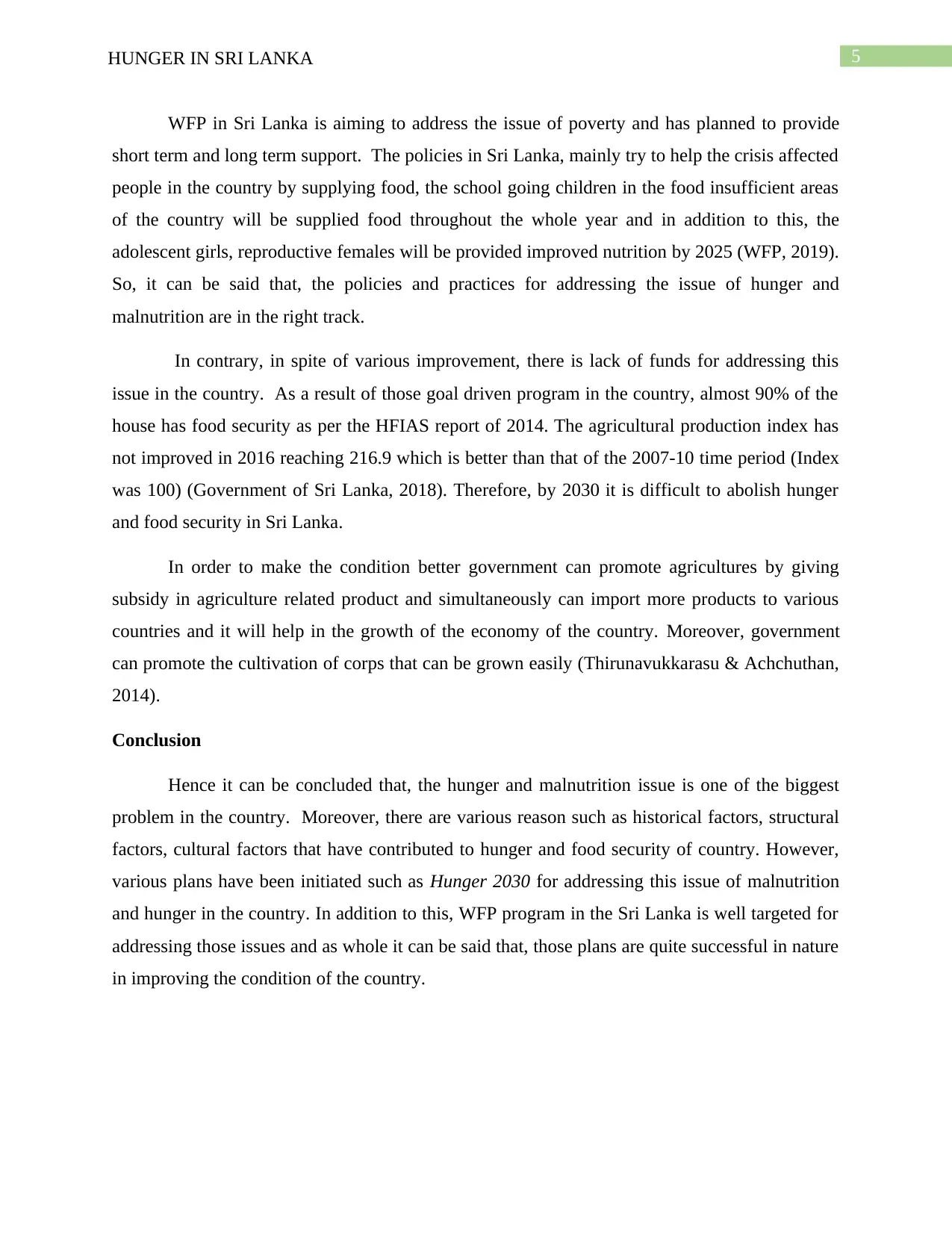
5HUNGER IN SRI LANKA
WFP in Sri Lanka is aiming to address the issue of poverty and has planned to provide
short term and long term support. The policies in Sri Lanka, mainly try to help the crisis affected
people in the country by supplying food, the school going children in the food insufficient areas
of the country will be supplied food throughout the whole year and in addition to this, the
adolescent girls, reproductive females will be provided improved nutrition by 2025 (WFP, 2019).
So, it can be said that, the policies and practices for addressing the issue of hunger and
malnutrition are in the right track.
In contrary, in spite of various improvement, there is lack of funds for addressing this
issue in the country. As a result of those goal driven program in the country, almost 90% of the
house has food security as per the HFIAS report of 2014. The agricultural production index has
not improved in 2016 reaching 216.9 which is better than that of the 2007-10 time period (Index
was 100) (Government of Sri Lanka, 2018). Therefore, by 2030 it is difficult to abolish hunger
and food security in Sri Lanka.
In order to make the condition better government can promote agricultures by giving
subsidy in agriculture related product and simultaneously can import more products to various
countries and it will help in the growth of the economy of the country. Moreover, government
can promote the cultivation of corps that can be grown easily (Thirunavukkarasu & Achchuthan,
2014).
Conclusion
Hence it can be concluded that, the hunger and malnutrition issue is one of the biggest
problem in the country. Moreover, there are various reason such as historical factors, structural
factors, cultural factors that have contributed to hunger and food security of country. However,
various plans have been initiated such as Hunger 2030 for addressing this issue of malnutrition
and hunger in the country. In addition to this, WFP program in the Sri Lanka is well targeted for
addressing those issues and as whole it can be said that, those plans are quite successful in nature
in improving the condition of the country.
WFP in Sri Lanka is aiming to address the issue of poverty and has planned to provide
short term and long term support. The policies in Sri Lanka, mainly try to help the crisis affected
people in the country by supplying food, the school going children in the food insufficient areas
of the country will be supplied food throughout the whole year and in addition to this, the
adolescent girls, reproductive females will be provided improved nutrition by 2025 (WFP, 2019).
So, it can be said that, the policies and practices for addressing the issue of hunger and
malnutrition are in the right track.
In contrary, in spite of various improvement, there is lack of funds for addressing this
issue in the country. As a result of those goal driven program in the country, almost 90% of the
house has food security as per the HFIAS report of 2014. The agricultural production index has
not improved in 2016 reaching 216.9 which is better than that of the 2007-10 time period (Index
was 100) (Government of Sri Lanka, 2018). Therefore, by 2030 it is difficult to abolish hunger
and food security in Sri Lanka.
In order to make the condition better government can promote agricultures by giving
subsidy in agriculture related product and simultaneously can import more products to various
countries and it will help in the growth of the economy of the country. Moreover, government
can promote the cultivation of corps that can be grown easily (Thirunavukkarasu & Achchuthan,
2014).
Conclusion
Hence it can be concluded that, the hunger and malnutrition issue is one of the biggest
problem in the country. Moreover, there are various reason such as historical factors, structural
factors, cultural factors that have contributed to hunger and food security of country. However,
various plans have been initiated such as Hunger 2030 for addressing this issue of malnutrition
and hunger in the country. In addition to this, WFP program in the Sri Lanka is well targeted for
addressing those issues and as whole it can be said that, those plans are quite successful in nature
in improving the condition of the country.

6HUNGER IN SRI LANKA
References
Amantha Perera, As drought slashes rice harvest, 900,000 face hunger in Sri Lanka. (2017).
Retrieved from Retrieved from https://www.reuters.com/article/us-sri-lanka-drought-
hunger-idUSKBN16K1HW
Amjath-Babu, T. S., Aggarwal, P. K., & Vermeulen, S. (2019). Climate action for food security
in South Asia? Analyzing the role of agriculture in nationally determined contributions to
the Paris agreement. Climate Policy, 19(3), 283-298. Retrieved from
https://doi.org/10.1080/14693062.2018.1501329
Ashraf, N., Field, E., Rusconi, G., Voena, A., & Ziparo, R. (2017). Traditional beliefs and
learning about maternal risk in Zambia. American Economic Review, 107(5), 511-15.
Retrieved from DOI: 10.1257/aer. p20171106
Corea, E., Karunanayake, P., & Ginige, S. (2018). Health situation and challenges in Sri
Lanka. Asian Pacific Journal of Tropical Medicine, 11(13), 21.
Retrieved from DOI: 10.4103/1995-7645.243086
Davis, K. F., Gephart, J. A., & Gunda, T. (2016). Sustaining food self-sufficiency of a nation:
The case of Sri Lankan rice production and related water and fertilizer
demands. Ambio, 45(3), 302-312.
De Silva, I. (2016). Why Growth and Redistribution Matter for Poverty Reduction: Evidence
from Sri Lanka on the Elusive Quest for Pro‐Poor Growth. Journal of International
Development, 28(8), 1272-1293. Retrieved from https://doi.org/10.1002/jid.3103
Global Hunger Index. (2018). Sri Lanka. Retrieved from https://www.globalhungerindex.org/sri-
lanka.html
References
Amantha Perera, As drought slashes rice harvest, 900,000 face hunger in Sri Lanka. (2017).
Retrieved from Retrieved from https://www.reuters.com/article/us-sri-lanka-drought-
hunger-idUSKBN16K1HW
Amjath-Babu, T. S., Aggarwal, P. K., & Vermeulen, S. (2019). Climate action for food security
in South Asia? Analyzing the role of agriculture in nationally determined contributions to
the Paris agreement. Climate Policy, 19(3), 283-298. Retrieved from
https://doi.org/10.1080/14693062.2018.1501329
Ashraf, N., Field, E., Rusconi, G., Voena, A., & Ziparo, R. (2017). Traditional beliefs and
learning about maternal risk in Zambia. American Economic Review, 107(5), 511-15.
Retrieved from DOI: 10.1257/aer. p20171106
Corea, E., Karunanayake, P., & Ginige, S. (2018). Health situation and challenges in Sri
Lanka. Asian Pacific Journal of Tropical Medicine, 11(13), 21.
Retrieved from DOI: 10.4103/1995-7645.243086
Davis, K. F., Gephart, J. A., & Gunda, T. (2016). Sustaining food self-sufficiency of a nation:
The case of Sri Lankan rice production and related water and fertilizer
demands. Ambio, 45(3), 302-312.
De Silva, I. (2016). Why Growth and Redistribution Matter for Poverty Reduction: Evidence
from Sri Lanka on the Elusive Quest for Pro‐Poor Growth. Journal of International
Development, 28(8), 1272-1293. Retrieved from https://doi.org/10.1002/jid.3103
Global Hunger Index. (2018). Sri Lanka. Retrieved from https://www.globalhungerindex.org/sri-
lanka.html
Paraphrase This Document
Need a fresh take? Get an instant paraphrase of this document with our AI Paraphraser
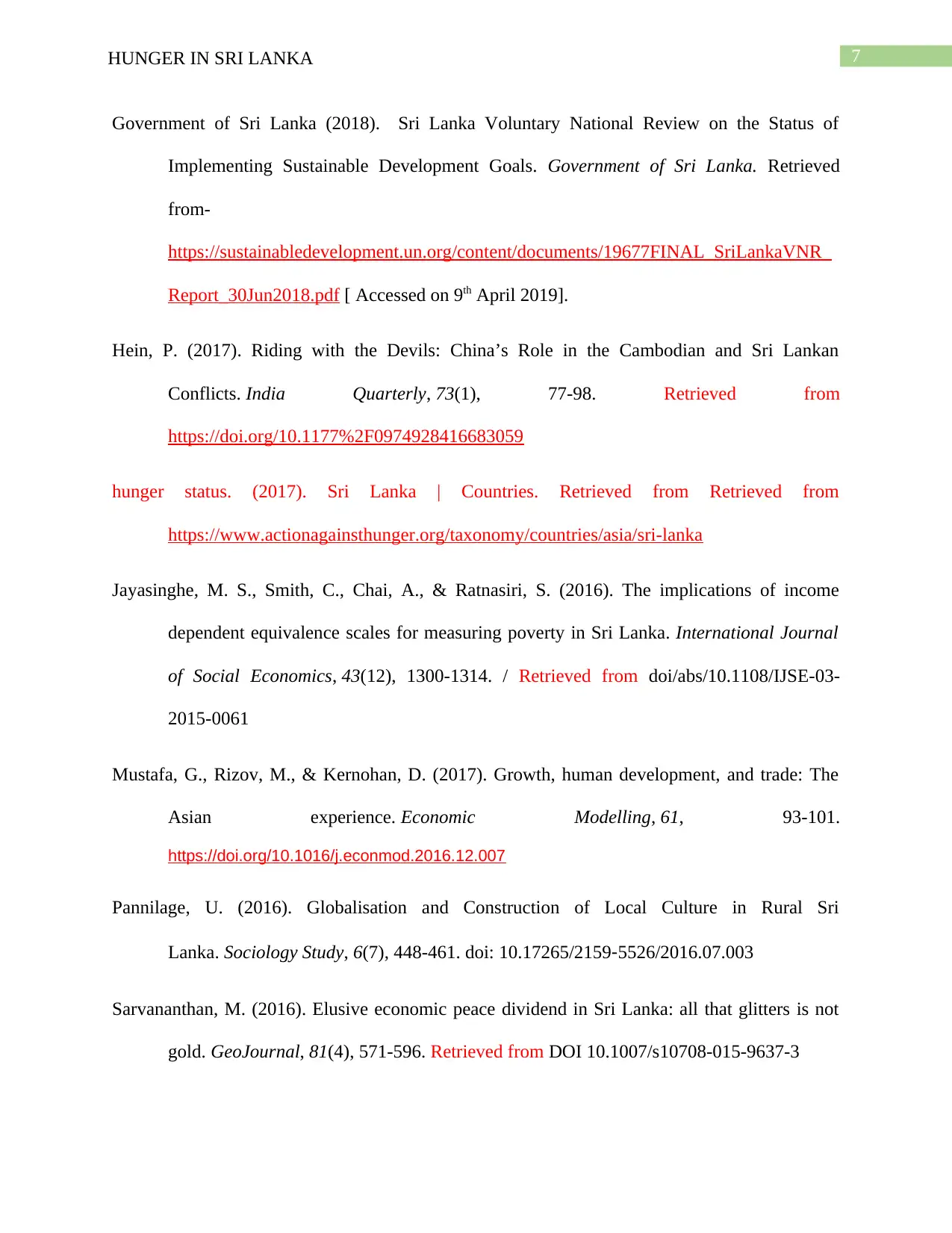
7HUNGER IN SRI LANKA
Government of Sri Lanka (2018). Sri Lanka Voluntary National Review on the Status of
Implementing Sustainable Development Goals. Government of Sri Lanka. Retrieved
from-
https://sustainabledevelopment.un.org/content/documents/19677FINAL_SriLankaVNR_
Report_30Jun2018.pdf [ Accessed on 9th April 2019].
Hein, P. (2017). Riding with the Devils: China’s Role in the Cambodian and Sri Lankan
Conflicts. India Quarterly, 73(1), 77-98. Retrieved from
https://doi.org/10.1177%2F0974928416683059
hunger status. (2017). Sri Lanka | Countries. Retrieved from Retrieved from
https://www.actionagainsthunger.org/taxonomy/countries/asia/sri-lanka
Jayasinghe, M. S., Smith, C., Chai, A., & Ratnasiri, S. (2016). The implications of income
dependent equivalence scales for measuring poverty in Sri Lanka. International Journal
of Social Economics, 43(12), 1300-1314. / Retrieved from doi/abs/10.1108/IJSE-03-
2015-0061
Mustafa, G., Rizov, M., & Kernohan, D. (2017). Growth, human development, and trade: The
Asian experience. Economic Modelling, 61, 93-101.
https://doi.org/10.1016/j.econmod.2016.12.007
Pannilage, U. (2016). Globalisation and Construction of Local Culture in Rural Sri
Lanka. Sociology Study, 6(7), 448-461. doi: 10.17265/2159‐5526/2016.07.003
Sarvananthan, M. (2016). Elusive economic peace dividend in Sri Lanka: all that glitters is not
gold. GeoJournal, 81(4), 571-596. Retrieved from DOI 10.1007/s10708-015-9637-3
Government of Sri Lanka (2018). Sri Lanka Voluntary National Review on the Status of
Implementing Sustainable Development Goals. Government of Sri Lanka. Retrieved
from-
https://sustainabledevelopment.un.org/content/documents/19677FINAL_SriLankaVNR_
Report_30Jun2018.pdf [ Accessed on 9th April 2019].
Hein, P. (2017). Riding with the Devils: China’s Role in the Cambodian and Sri Lankan
Conflicts. India Quarterly, 73(1), 77-98. Retrieved from
https://doi.org/10.1177%2F0974928416683059
hunger status. (2017). Sri Lanka | Countries. Retrieved from Retrieved from
https://www.actionagainsthunger.org/taxonomy/countries/asia/sri-lanka
Jayasinghe, M. S., Smith, C., Chai, A., & Ratnasiri, S. (2016). The implications of income
dependent equivalence scales for measuring poverty in Sri Lanka. International Journal
of Social Economics, 43(12), 1300-1314. / Retrieved from doi/abs/10.1108/IJSE-03-
2015-0061
Mustafa, G., Rizov, M., & Kernohan, D. (2017). Growth, human development, and trade: The
Asian experience. Economic Modelling, 61, 93-101.
https://doi.org/10.1016/j.econmod.2016.12.007
Pannilage, U. (2016). Globalisation and Construction of Local Culture in Rural Sri
Lanka. Sociology Study, 6(7), 448-461. doi: 10.17265/2159‐5526/2016.07.003
Sarvananthan, M. (2016). Elusive economic peace dividend in Sri Lanka: all that glitters is not
gold. GeoJournal, 81(4), 571-596. Retrieved from DOI 10.1007/s10708-015-9637-3
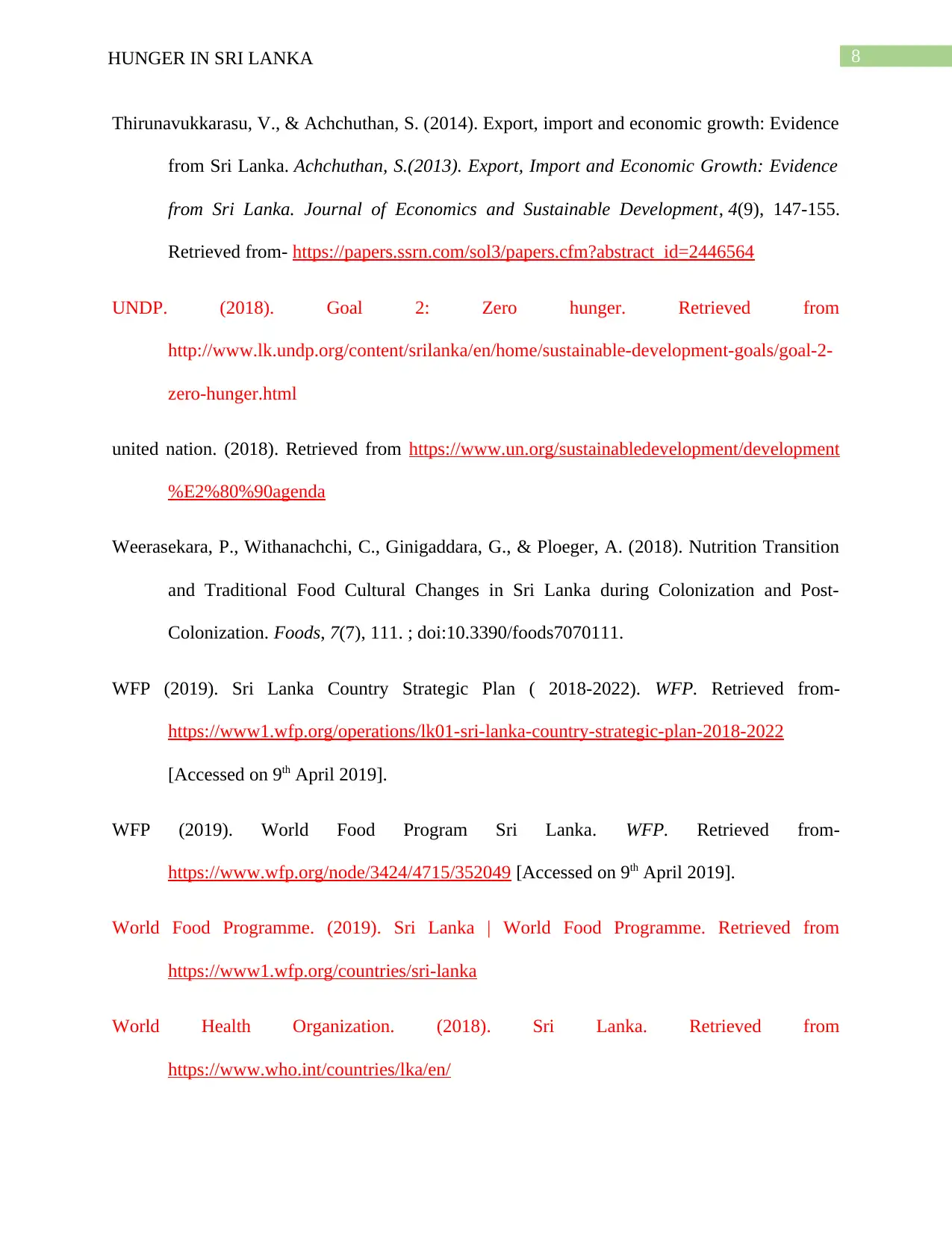
8HUNGER IN SRI LANKA
Thirunavukkarasu, V., & Achchuthan, S. (2014). Export, import and economic growth: Evidence
from Sri Lanka. Achchuthan, S.(2013). Export, Import and Economic Growth: Evidence
from Sri Lanka. Journal of Economics and Sustainable Development, 4(9), 147-155.
Retrieved from- https://papers.ssrn.com/sol3/papers.cfm?abstract_id=2446564
UNDP. (2018). Goal 2: Zero hunger. Retrieved from
http://www.lk.undp.org/content/srilanka/en/home/sustainable-development-goals/goal-2-
zero-hunger.html
united nation. (2018). Retrieved from https://www.un.org/sustainabledevelopment/development
%E2%80%90agenda
Weerasekara, P., Withanachchi, C., Ginigaddara, G., & Ploeger, A. (2018). Nutrition Transition
and Traditional Food Cultural Changes in Sri Lanka during Colonization and Post-
Colonization. Foods, 7(7), 111. ; doi:10.3390/foods7070111.
WFP (2019). Sri Lanka Country Strategic Plan ( 2018-2022). WFP. Retrieved from-
https://www1.wfp.org/operations/lk01-sri-lanka-country-strategic-plan-2018-2022
[Accessed on 9th April 2019].
WFP (2019). World Food Program Sri Lanka. WFP. Retrieved from-
https://www.wfp.org/node/3424/4715/352049 [Accessed on 9th April 2019].
World Food Programme. (2019). Sri Lanka | World Food Programme. Retrieved from
https://www1.wfp.org/countries/sri-lanka
World Health Organization. (2018). Sri Lanka. Retrieved from
https://www.who.int/countries/lka/en/
Thirunavukkarasu, V., & Achchuthan, S. (2014). Export, import and economic growth: Evidence
from Sri Lanka. Achchuthan, S.(2013). Export, Import and Economic Growth: Evidence
from Sri Lanka. Journal of Economics and Sustainable Development, 4(9), 147-155.
Retrieved from- https://papers.ssrn.com/sol3/papers.cfm?abstract_id=2446564
UNDP. (2018). Goal 2: Zero hunger. Retrieved from
http://www.lk.undp.org/content/srilanka/en/home/sustainable-development-goals/goal-2-
zero-hunger.html
united nation. (2018). Retrieved from https://www.un.org/sustainabledevelopment/development
%E2%80%90agenda
Weerasekara, P., Withanachchi, C., Ginigaddara, G., & Ploeger, A. (2018). Nutrition Transition
and Traditional Food Cultural Changes in Sri Lanka during Colonization and Post-
Colonization. Foods, 7(7), 111. ; doi:10.3390/foods7070111.
WFP (2019). Sri Lanka Country Strategic Plan ( 2018-2022). WFP. Retrieved from-
https://www1.wfp.org/operations/lk01-sri-lanka-country-strategic-plan-2018-2022
[Accessed on 9th April 2019].
WFP (2019). World Food Program Sri Lanka. WFP. Retrieved from-
https://www.wfp.org/node/3424/4715/352049 [Accessed on 9th April 2019].
World Food Programme. (2019). Sri Lanka | World Food Programme. Retrieved from
https://www1.wfp.org/countries/sri-lanka
World Health Organization. (2018). Sri Lanka. Retrieved from
https://www.who.int/countries/lka/en/
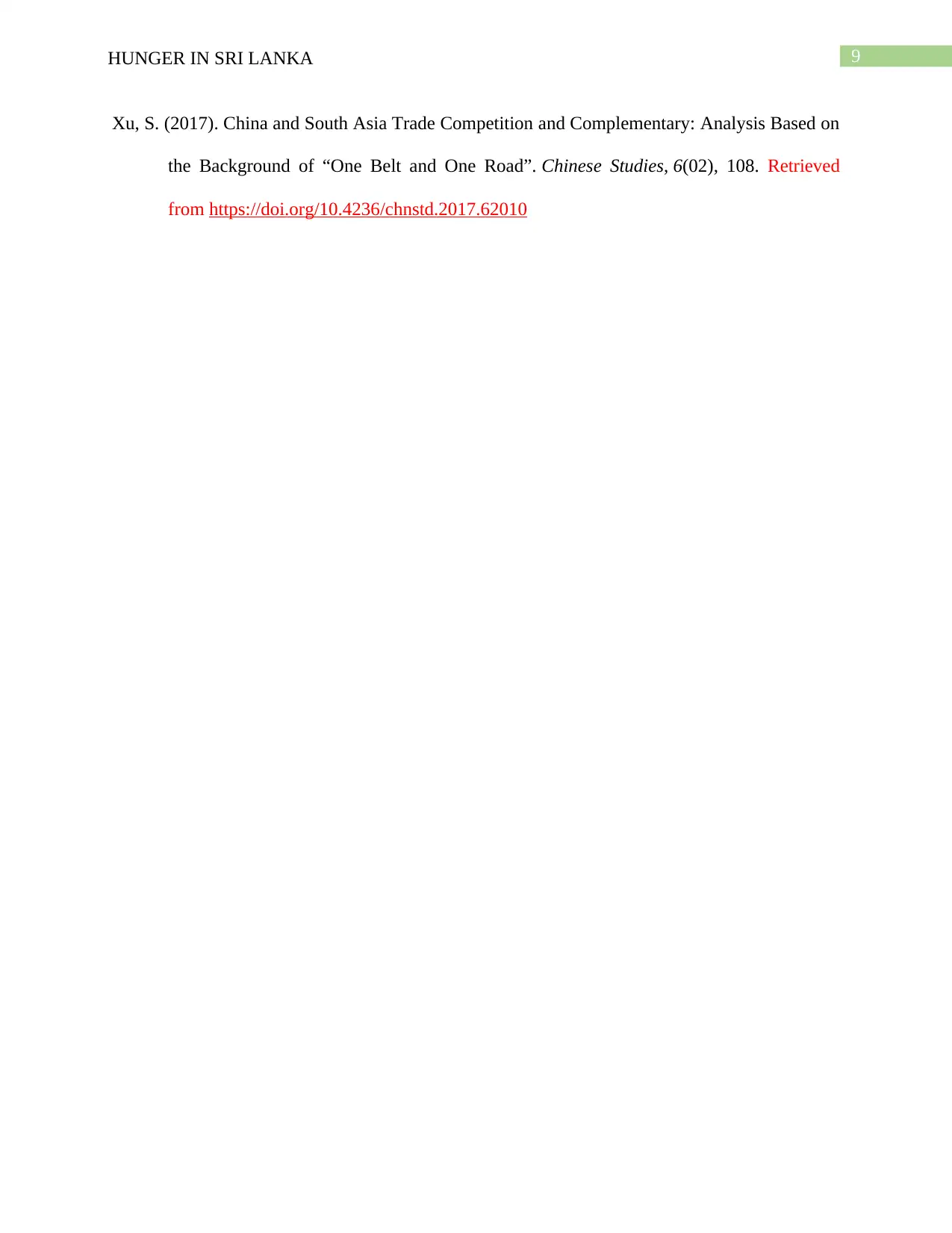
9HUNGER IN SRI LANKA
Xu, S. (2017). China and South Asia Trade Competition and Complementary: Analysis Based on
the Background of “One Belt and One Road”. Chinese Studies, 6(02), 108. Retrieved
from https://doi.org/10.4236/chnstd.2017.62010
Xu, S. (2017). China and South Asia Trade Competition and Complementary: Analysis Based on
the Background of “One Belt and One Road”. Chinese Studies, 6(02), 108. Retrieved
from https://doi.org/10.4236/chnstd.2017.62010
1 out of 10
Your All-in-One AI-Powered Toolkit for Academic Success.
+13062052269
info@desklib.com
Available 24*7 on WhatsApp / Email
![[object Object]](/_next/static/media/star-bottom.7253800d.svg)
Unlock your academic potential
© 2024 | Zucol Services PVT LTD | All rights reserved.



